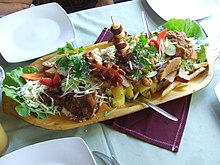Fatányéros


Fatányéros, also called Hungarian mixed grill,[1] is a traditional Hungarian mixed meat barbecue dish (or pecsenye in Hungarian), originating from Transylvania.
In Scandinavia, the name of the dish is commonly translated as plank steak (Danish: plankebøf, Swedish: plankstek), and it usually includes duchess potatoes.
In Hungary
[edit]The dish Fatányéros was on the menu since 1900 at the famous restaurant Wampetich (later Gundel) in the City Park (Városliget) in Budapest, as "fatányéros—Hungarian mixed grill on wooden platter". The dish was served on wooden platter,[2] and contained grilled slices of veal, beef, pork cutlets, and a slice of goose liver and a slice of bacon—grilled or roasted on a spit. As a side dish french fries or thick slices of fried potatoes are served, together with fresh mixed green salad, with a big knife with Hungarian motives stuck in the middle of the steak.
Steaks called pecsenye (cf. Serbo-Croatian: pečenje) are part of the traditional Hungarian cuisine and may refer to any kind of pan fried meat: pork, beef, poultry or game. These steaks are often served on a wooden platter, like Bakonyi pecsenye, Cigánypecsenye, Tordai pecsenye or Erdélyi fatányéros, arranged in a very decorative way with garnishing, fried vegetables and salad.
In Scandinavia
[edit]The dish is also popular in Scandinavia, although it is slightly different than the Hungarian version. In Denmark it goes by the name plankebøf, and in Sweden as plankstek, meaning "plank roast". It is commonly served with duchess potatoes, vegetables, and Béarnaise sauce.[3]
The Swedish book Maträtternas historia, rewarded "best book in culinary history" in 2020 by Gourmand Awards, has a different theory of the origin of the dish. It describes how Native Americans used to cook fish and sometimes meat on a cherry plank. The first time a similar course appears in New York in Charles Ranhofer's cookbook The Epicurean from 1893.
See also
[edit]References
[edit]- ^ Gundel, Karoly (1992). Gundel's Hungarian cookbook. Budapest: Corvina. p. 83. ISBN 963-13-3600-X. OCLC 32227400.
- ^ "Famous Hungarian recipes". Archived from the original on 2016-09-16. Retrieved 2016-09-05.
- ^ Duxbury, John (2018-04-27). "Recipe: How to make classic Swedish steak on a plank". The Local. Archived from the original on 2020-10-26. Retrieved 2020-10-24.

